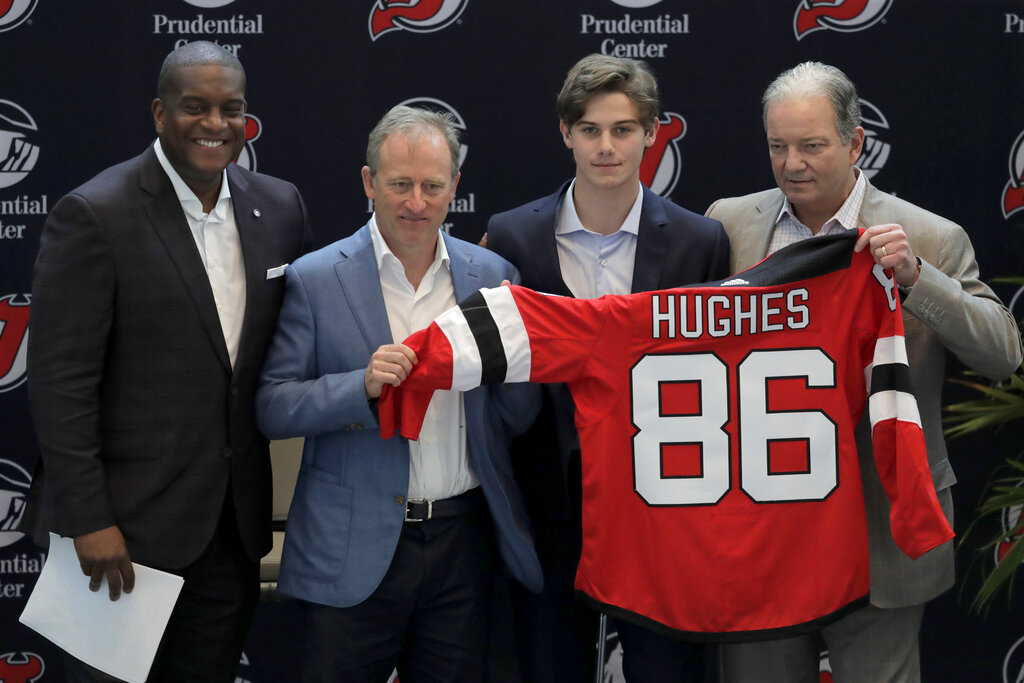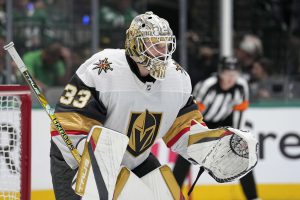Table of Contents

The NHL Draft is an annual opportunity for the league’s 32 organizations to stock up on fresh talent with the aim of adding future stars to their arsenal. Every summer, the NHL crowns a champion, with its best angling for the ultimate prize of the Stanley Cup. For those on the opposite end of the league, there is something else to look forward to in the warmer months, and it doesn’t happen on the ice.
When Is The NHL Draft?
The 2023 NHL Entry Draft is set for June 28-29 in Nashville, Tennessee. The first round will take place on June 28 at 7 p.m. ET, with rounds 2-7 to follow on June 29 beginning at 11 a.m. ET. Over the course of those two days, the league’s teams will have seven rounds to select from a large pool of players hoping to hear their name and carve out a career for themselves in the National Hockey League. The opportunities for front offices are plentiful, and their decisions during the draft have ramifications for campaigns to come.
10 NHL Draft FAQs
How Many Rounds Are in the NHL Draft?
The draft has seven rounds. Each round includes the space for one pick for each franchise. With 32 franchises and seven rounds, that means more than 200 players will be assigned to an NHL organization in any given draft.
Who Can Be Selected in the Draft?
North Americans who will be 18 by September 15 and younger than 21 by December 31 are eligible for the 2023 NHL Draft. Players from other continents also must be 18 or older by September 15 but don’t have any other age restrictions. If a player will be 18 by September 15, they have to declare themselves eligible for the draft, while those 19 or older by said date are not asked to complete the extra step.
How Is the Draft Order Determined?
That depends on the portion of the draft, but in all rounds, the draft order is determined through different means in the first and second halves.
In the first round, the first 16 picks are ordered through the NHL Draft Lottery. The half of the league that did not make the Stanley Cup Playoffs is eligible for it. The order for picks 17-32 is determined through a combination of regular season record and playoff performance. Playoff teams that lose in the first or second rounds of the playoffs and did not win their divisions are given the next picks with the league standings serving as the tiebreaker. Next are the teams that also lost before the conference finals but did win their divisions. Picks 29-30 go to the teams that lose in the conference finals, No. 31 goes to the loser of the Stanley Cup Finals, and the final draft position goes to the league’s champion.
For example, the Seattle Kraken made the playoffs but did not survive until the conference finals or win their division. Among the 10-total teams that fell into this pile this year, the Kraken had the fourth-worst regular season record. As such, Seattle will have the 20th pick in each round this summer. Meanwhile, the Colorado Avalanche and Boston Bruins also made the playoffs, did not make the conference finals, but were winners of their respective divisions. Boston had a better regular season record than Colorado, so the Avalanche are No. 27 and the Bruins are No. 28.
The lottery does not apply to the other six rounds in the NHL Draft. The draft order in those rounds is decided by reversing the regular season standings for the first 16 picks and copying the template from the first round in the last 16 picks. The team that ends dead-last in the regular season standings is guaranteed the top selection in all but the first round. This means that the Anaheim Ducks are at the top of the pecking order in rounds 2-7.
How Does the NHL Draft Lottery Work?
The NHL Draft Lottery is used to determine the top-three overall picks in the draft. All 16 teams that did not play in the postseason are included, but no team may jump more than 10 spots in the draft order; therefore, only the 11 worst teams in the league, by regular season record, are eligible for the first overall pick.
Weighted odds are distributed to each of the 16 participants based on their position in the regular season standings. The best odds are given to the teams with the worst records before lottery balls are drawn to determine who will have the opening selections of the draft.
To understand how this works in practice, let’s look at the lottery that just happened.
With 58 points, Anaheim finished at the bottom of the 2022-23 regular season standings. As such, the Ducks had the best odds at the No. 1 pick at the 2023 NHL Draft Lottery on May 8. These were the weighted odds for all 16 entrants in the latest lottery:
1: Anaheim Ducks, 18.5% (25.5% at No. 1 overall)
2: Columbus Blue Jackets, 13.5% (13.5% at No. 1 overall)
3: Chicago Blackhawks, 11.5% (11.5% at No. 1 overall)
4: San Jose Sharks, 9.5% (9.5% at No. 1 overall)
5: Montreal Canadiens, 8.5% (8.5% at No. 1 overall)
6: Arizona Coyotes, 7.5% (7.5% at No. 1 overall)
7: Philadelphia Flyers, 6.5% (6.5% at No. 1 overall)
8: Washington Capitals, 6.0% (6.0% at No. 1 overall)
9: Detroit Red Wings, 5.0% (5.0% at No. 1 overall)
10: St. Louis Blues, 3.5% (3.5% at No. 1 overall)
11: Vancouver Canucks, 3.0% (3.0% at No. 1 overall)
12: Ottawa Senators, 2.5% (0% at No. 1 overall)
13: Buffalo Sabres, 2.0% (0% at No. 1 overall)
14: Pittsburgh Penguins, 1.5% (0% at No. 1 overall)
15: Nashville Predators, 0.5% (0% at No. 1 overall)
16: Calgary Flames, 0.5% (0% at No. 1 overall)
Anaheim did not win the first pick, though. Chicago was the lucky one, and so the Blackhawks will have the No. 1 overall pick this summer. The Ducks did at least secure the second selection, and the Blue Jackets fell to third. So, the lottery shoved Anaheim and Columbus down one spot each, Chicago made the jump, and the rest of the draft order will be the same as shown above.
Why Does the Lottery Exist?
The idea behind the NHL Draft Lottery is to prevent tanking. Teams that do not expect to or are not contending for the Cup have incentive to lose to get a better draft pick and ideally transform the fortunes of the franchise. While this method has worked many times before, it’s not a great thing for a sports league like the NHL that wants to put out a competitive product for fans to engage with every night of the week. The lottery removes the certainty that tanking will pay off, though it doesn’t stop it from happening.
Another wrinkle the NHL has added to the draft lottery in an effort to curb tanking is limiting how often a team can get the top pick. No franchise is allowed to win the lottery more than twice in a five-year span, which theoretically prevents teams from being intentionally woeful for years on end; the NHL would like to avoid another 2010s Edmonton Oilers situation happening again.
Can Team Trade Their Draft Choices?
Yes, teams can trade their draft choices. They can trade picks they haven’t used yet or players they just drafted.
It is typical for teams that are rebuilding to look for picks in trades and for franchises that are contending to sacrifice draft selections for assets that will help them now. Draft day is often full of trades, some big and many small. Draft picks are commonly traded throughout the year, too. You can also trade picks from future drafts.
How Are Draft-Eligible Players Scouted?
NHL teams have armies of scouts who watch young talent play across the world. They watch major junior leagues, like the WHL, OHL, or Quebec’s QMJHL, and NCAA games, which is where the Canadian and American players normally are. They also visit Europe to monitor the talent across the ocean, too.
Scouts are often former players, coaches, or people who have otherwise spent many years in hockey and have a good idea of what they’re looking for. The input they give their teams about draft-eligible players has a strong impact on what happens on draft day.
There are also people and entities that scout prospects independently, like media outlets and obsessed hockey fans with internet connections. These sorts of things can be easily found online.
The majority of hockey players come from Canada, the United States, Russia, Sweden, Finland, Czech Republic, with Germany, Slovakia, and Switzerland pitching in some players as well. As the sport has grown, more nations have entered into the fold, though it is still a relatively tight circle of countries that generate most of the game’s goods.
What Happens When You Get Drafted in the NHL?
There are a few roads players can go after they’ve been drafted.
The first deal a player usually signs is an entry-level contract (ELC). These types of contracts cap the player’s annual salary at $925,000 and are two-way deals, which means the player’s salary can be different if they’re playing in the NHL or the minors. ELCs vary in length depending on the age of the player.
Ages 18-21: three years
Ages 22-23: two years
Age 24: one year
Players are eligible to play in the NHL at 18 years old, but this is not the norm. Only the best prospects – generally a select few of the top 10 picks – immediately hit NHL ice the following fall. The rest either continue to develop in their respective leagues as they were or sign their entry-level contract and play for their NHL team’s AHL affiliate. You can be 20 years old and still play junior hockey, and many drafted players do just that.
Many players who are drafted will never sign an entry-level contract or see NHL ice, and many players who hope to be picked are not. Undrafted players can resubmit again, with an age limit of 20 for North Americans and 21 for Europeans, or they can sign an ELC with any NHL team. Plenty of undrafted players, like Martin St. Louis, Sergei Bobrovsky, and Mark Giordano, have gone on to have great NHL careers.
How Does the NHL Draft Work for College Players?
Most draftees are not immediately ready to become NHL players right after being drafted. Instead, they find somewhere else to spend some important developmental seasons with the goal of getting to the big time in a few years. One option in the NCAA, which offers an opportunity to get an education while improving at hockey, too. It also gives the player much more potential leverage in deciding where they will start their NHL career.
An NCAA player who has not signed a contract with their draft team within 30 days of finishing their collegiate education and playing career becomes an unrestricted free agent. There have been many instances of college athletes playing their full college careers and intentionally not signing with their draft team so they can choose where to go when the time comes. Jimmy Vesey, Kevin Hayes, Alexander Kerfoot, and Adam Fox are a handful of the most notable players who have done this in the last 15 years.
It is also normal for undrafted prospects to play NCAA hockey, show what they can do, and become wanted commodities in the free agent market years down the line.
What Is a Compensatory Pick?
If an NHL team doesn’t sign its first-round pick within two years of drafting them, then it is given a compensatory pick in a future draft. This comes in the form of a second-round pick that matches the selection number of the player the team is being compensated for. This adds a pick to the second round and pushes everyone else back one spot.
These are fairly rare, but they do happen. After choosing not to sign 2018 first-round pick Filip Johansson, the Minnesota Wild were granted a compensatory pick in the 2022 NHL Draft. The NHL created a new No. 56 overall pick in the draft to correspond with the No. 24 overall pick the Wild used years prior, awarded it to Minnesota, and moved all subsequent teams down by one. It was the first time since the 2016 NHL Draft that a team gained a compensatory pick in this way.
Join RYP’s NHL Hockey Pools & Get in On the Action!
Put your NHL knowledge to the test in any of Run Your Pool’s awesome hockey pools! RYP has pick ‘em pools, survivor pools, and an NHL Playoff power ranking game that will have you on the edge of your seat all playoffs long.
RYP removes the massive amount of work it takes to operate and manage a sports pool. No more manually tracking how teams did against the spread, regularly maintaining leaderboards, or fielding tons of messages from confused competitors anxious for updates. With RYP, everything is conveniently in one place, with the tedium removed so only the excitement of sports and competition remains!
NHL FAQs
How do you play NHL Survivor Pool?

In an NHL survivor pool, members choose one team from the Saturday games (or games for that week). Each team can only be picked once throughout the season. If they win, the member moves on to the next week. If they lose, the member is eliminated. The last member standing is the winner.
What is NHL Survivor Pool?

In an NHL survivor pool, each member picks one NHL team to win for the week. Each team can only be chosen once during the season. If their pick wins, the member moves on to the following week. If they do not win, the member is disqualified. The last one standing wins.
How to make an NHL pool?

You can just use a hockey pool hosting service like RunYourPool where we do all the work for you! Just sign up to create your own pool, customize your pool settings and invite your friends to play!
How do you play NHL Pick'em Pool?

In NHL Pick'em pools, members will pick the winner of games. The pool commissioner has options to have members pick all games or a specific amount. For each correct pick during regular season, members receive one point. The person with the most points at the end of season wins. Administrators can choose to have 'best bet' picks or 'confidence' points as well.
What is NHL Pick'em Pool?

NHL Pick'em pools have members select the outright winner of each game. The specific amount of games picked is up to the pool commissioner. For every correct pick, members receive one point. These pools typically end in the regular season, as the person with the most points wins. Also, commissioners can choose to have 'confidence' points or 'best bet ' picks.
How to set up an NHL pool?

To set up an NHL pool, you'll need to first choose a pool type like Survivor or Pick'em. Then, you'll need to set the ground rules. As pool commissioner, you'll enforce these rules and make sure the game runs smoothly throughout the season. Many commissioners use pool hosting sites like RunYourPool to make it easier and more engaging.
How to run a weekly NHL pool?

In order to run an NHL pool, you must first crown yourself as Pool Commissioner. Begin by picking a game type like Survivor or Pick'Em. You'll want to establish rules before inviting friends, family, and colleagues to join. As commissioner, you make the rules and also need to enforce them equally and fairly.
How do you play NHL Playoff Pools Power Ranking?

To play in an NHL Playoffs Power Ranking Pool, you need to assign a point value to each NHL team from highest (16) to lowest (1). When a team wins, they receive points based on the number you assigned to them! The member with the most points at the end of the playoffs wins.
What is NHL Playoff Pools Power Ranking?

An NHL Playoff Power Ranking Pool involves all members ranking all 16 NHL teams competing in the NHL Playoffs from strongest (16 points) to weakest (1 point). Members are awarded the number of points assigned to an NHL team when that team wins!
How to run an NHL pool?

How you decide to run a hockey pool varies greatly depending on the game type. In each case, however, you'll want to determine the rules and settings before you begin inviting members to join you. You'll want to clearly establish how score will be kept, how tiebreakers work, and how winners are decided before anything else.

